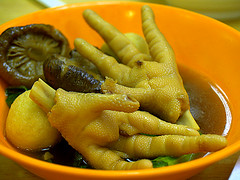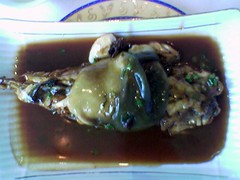1 million Graco, Simplicity beds called back after kids entrapped, suffocated after rails were improperly installed. The maker of Simplicity and Graco cribs on Friday recalled about 1 million of the beds after mishaps that led to the deaths of three infants. "Don't take a chance at all," said Scott Wolfson, a spokesman for the Consumer Product Safety Commission, which announced the voluntary recall by Reading, Pa.-based Simplicity Inc., one of the largest U.S. crib manufacturers. "If you are a parent or caregiver that has one of these cribs impacted by these recalls, your baby should not sleep in that crib tonight." The cribs, which were made in China and sold at major retailers nationwide, feature a "drop-side" railing that can pull away from the mattress. Infants can become trapped in the resulting gap and suffocate. Read Full Story
DEFINITION chi-na-free adj. A term proposed for use on food labels to show that products are not made in China.
CONTEXT In light of recent health and safety scares regarding Chinese-made food and products, a U.S.-based company called Food for Health International has announced plans to put "China-free" stickers on its goods. The subtext: These products won't make you sick or have harmful contaminants like melamine.
USAGE Given recent recalls of items from toys to toothpaste, China-free labeling could catch on, though consumers would do well to remember that not all products from China are tainted and not all tainted products are from China.
Friday, September 28, 2007
3 deaths spur recall of China Made cribs
Posted by
Blogmonger
at
6:26 PM
0
comments
![]()
Pork products poison 300 in Shanghai
Pork products containing residue of toxic chemical clenbuterol have poisoned more than 300 people in the city since Wednesday.
Food authorities have discovered that the contaminated pork was produced in neighbouring Zhejiang Province.
The clenbuterol (the general term is Shouroujing in Chinese) poisoning is the city's largest in terms of victim numbers in recent years. As of Wednesday, more than 300 patients from the city's nine districts have gone to hospitals for treatment. Victims vomited, convulsed and sweated for several hours after consuming the pork products.
Renji Hospital's Pudong Branch has received 97 patients in two days, many of whom are from one family.
Food authorities on Friday afternoon told China Daily that they were still counting the number of victims, none of whom where reported in serious condition.
The Shanghai Food and Drug Administration found that the pigs were bought by the Shanghai Agricultural Products Central Wholesale Market from East China's Zhejiang Province and then sold to local food markets. The market was required to stop operating on Friday. However, victims are unlikely to be compensated, according to food authorities.
"This batch of 189 pigs was sold to 66 local food markets. The rest of the pork products have been contained and police have detained the dealer," said Xu Wei, an official with the administration.
The pork was not the only source of the poisoning. Food officials found many victims were poisoned after consuming pig internal organs (liver, kidney and lungs) where the tissues gathered more clenbuterol residue.
Victims bought these products from unlicensed vendors around the markets, who got the products at very low prices from the wholesale market.
Source: China Daily
Posted by
Blogmonger
at
3:42 PM
0
comments
![]()
Poison clothes add to China export scares
The safety problems affecting Chinese goods spread from toys to textiles on Monday as New Zealand said it would investigate allegations that imported children’s clothes contained dangerous levels of formaldehyde. The government ordered the probe after scientists hired by a consumer watchdog programme discovered formaldehyde in Chinese clothes at levels of up to 900 times regarded as safe. Manufacturers sometimes apply formaldehyde to clothes to prevent mildew. It can cause skin rashes, irritation to the eyes and throat and allergic reactions. The Warehouse, a New Zealand retailer, issued a recall at the weekend for children’s pyjamas made in China after two children were burned when their flannelette nightclothes caught fire. The New Zealand investigation is the first time that the safety of Chinese clothes has been called into question; concerns have been raised over a series of Chinese products in recent months, including toys, food and toothpaste. Last week, Mattel said it was recalling 18.2m toys globally because of hazards such as the use of lead paint.
Posted by
Blogmonger
at
3:40 PM
0
comments
![]()
Lead-paint toys aren't the biggest risk
| Old paint on the wall and small playthings such as rubber balls pose a much greater threat than recalled products, experts say. Parents scoured children's playrooms and retailers scurried to clear their shelves after manufacturers ordered a series of recalls this summer, saying millions of popular toys may have been made with lead paint. But the risk of lead poisoning is as strong as ever, experts say; it's just that the biggest threat probably isn't in the toy box. Children are at greater risk of lead poisoning from living in a home with deteriorating old paint, or one that is going through a remodel, than they are from most toys, according to federal tallies. |
Toys with lead paint don't even pose the biggest threat among playthings. Lead paint has been banned in the U.S. since 1978, but older homes typically have layers of it beneath newer coats. In good condition and left undisturbed, the lead paint poses little threat. But after it's chipped or begins creating dust, the danger grows.
"By far and away historically, the major concern about sources for lead has been your home," said Dr. Helen Binns, a professor of pediatrics and preventive medicine at Northwestern University's medical school. "You may handle your toy for a few moments a day, but if you're in a home going through remodeling, you generate dust throughout your whole house," Binns said. "So you're exposed everywhere you go, not just when you're playing."
Posted by
Blogmonger
at
3:37 PM
0
comments
![]()
U.S. Recalls of China Goods Almost Triple Since June
Recalls of Chinese goods by U.S. companies almost tripled in the past three months, threatening to cut overseas revenue for the world's biggest consumer- products exporter.
Mattel Inc., the world's largest toymaker, withdrew more lead-tainted products from China last week, bringing the value of recalled toxic and dangerous Chinese goods to $430 million since June 6, from $152 million a year earlier, according to figures compiled from U.S. Consumer Product Safety Commission data. The value of goods withdrawn from American shelves this year totals $1.08 billion.
Retail products are fueling China's expansion, with the fastest-growing major economy exporting $344 billion of consumer goods last year. Safety scares including poisonous toothpaste, defective tires and harmful toys have hurt sales at companies from Mattel to Menu Foods Income Fund, the owner of a Canadian pet-food maker.
``Right now `Made in China' might be making consumers pause a little longer than they might have,'' said Sean McGowan, a Wedbush Morgan Securities analyst in New York.
Posted by
Blogmonger
at
3:29 PM
0
comments
![]()
260 Children Hospitalized after Food Poisoning in China
Two hundred and sixty children from a kindergarten in Wuwei City, Gansu Province, were hospitalized due to food poisoning, according to a report by Xinhua News Agency published on September 21.
An employee of Shiyan Kindergarten confirmed the incident, but said the number of sick children were not as high as reported. When asked about the exact number of victims and the cause of the incident, the employee only answered, "We are not allowed to accept any interviews." The manager of the kindergarten has been out of touch since the accident.
Wuwei City Public Security Bureau also confirmed the incident but refused to reveal any details. According to the employee who answered the phone, it would be up to "orders from above" when the details can be publicized.
The Chinese Communist Party usually categorizes food poisoning as "negative news" that should be avoided. Investigation outcomes for such incidents are not normally disclosed to the public, and people rarely find out if the officials in charge are punished. The unusually publicized report of this particular case by Xinhua News Agency has inspired suspicion that the situation is very serious.
Posted by
Blogmonger
at
3:27 PM
0
comments
![]()
56,000 lunch boxes in Calif. recalled for lead
| About 56,000 lunch boxes distributed by California in an effort to promote healthful eating may contain lead, and state officials Thursday urged consumers not to use them. |
Posted by
Blogmonger
at
3:19 PM
0
comments
![]()
After recalls, playthings pile high
Posted by
Blogmonger
at
3:19 PM
0
comments
![]()
1 million cribs sold in U.S. recalled
| Simplicity Inc. is recalling about 1 million Chinese-made baby cribs which have been linked to at least two infant deaths, the U.S. Consumer Product Safety Commission said on Friday. |
Posted by
Blogmonger
at
3:18 PM
0
comments
![]()
County, state offer help for lead issues
On a federal health agency's Web site, candy-colored photos show a variety of toys that could be any child's delight. Instead, the images show poison. The toys are many: Barbie Doll's dog, bongo drums, trains, watercolor kits, duck-shaped watering cans, jewelry sets, spiral-bound books, dinosaurs and garden gloves. All were recalled after tests found they were contaminated with lead, a toxin that when ingested can cause a raft of irrevocable problems to brains, kidneys, hearts and nervous systems. Children are especially vulnerable to lead poisoning.
But it's not just lead-tainted toys that have raised concern in recent weeks, as reflected by several recalls of products from China. Common items that might contain hazardous levels of lead include old wall paint, clothing, glassware, candy from Mexico, pottery, gasoline, herb concoctions, certain home remedies, soil and even dust.
Last week, the California Department of Public Health added an item to the lead-recall list: vinyl-lined lunchboxes with designs promoting fruits and vegetables.
Posted by
Blogmonger
at
3:17 PM
0
comments
![]()





